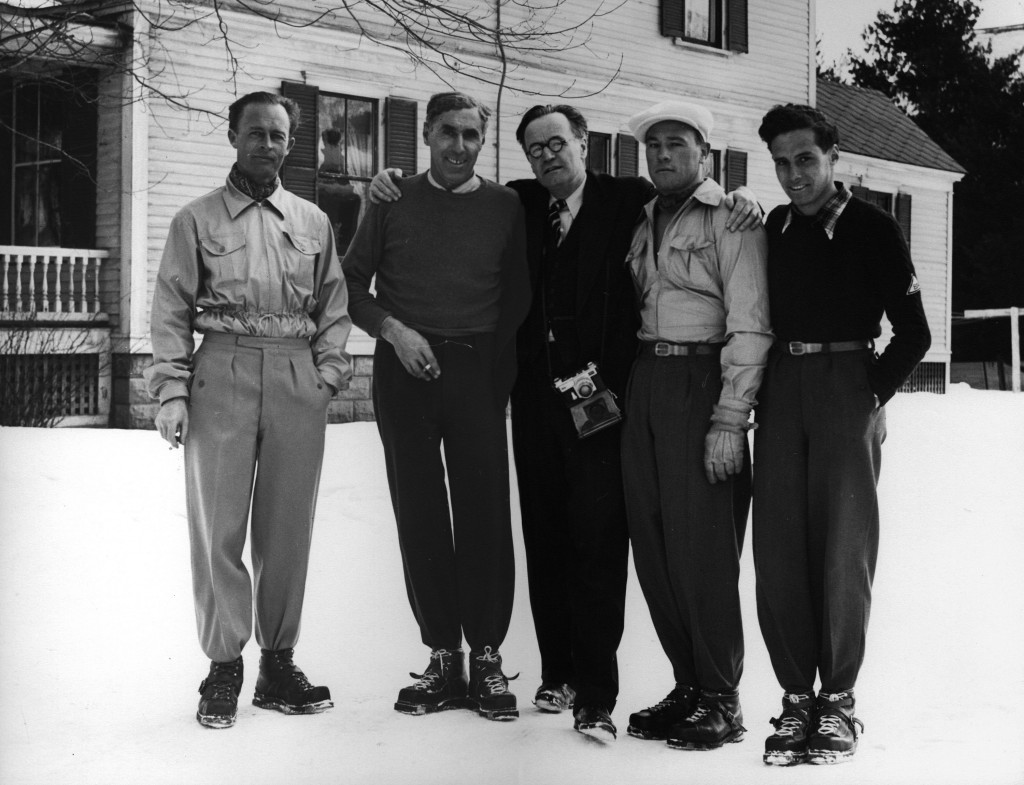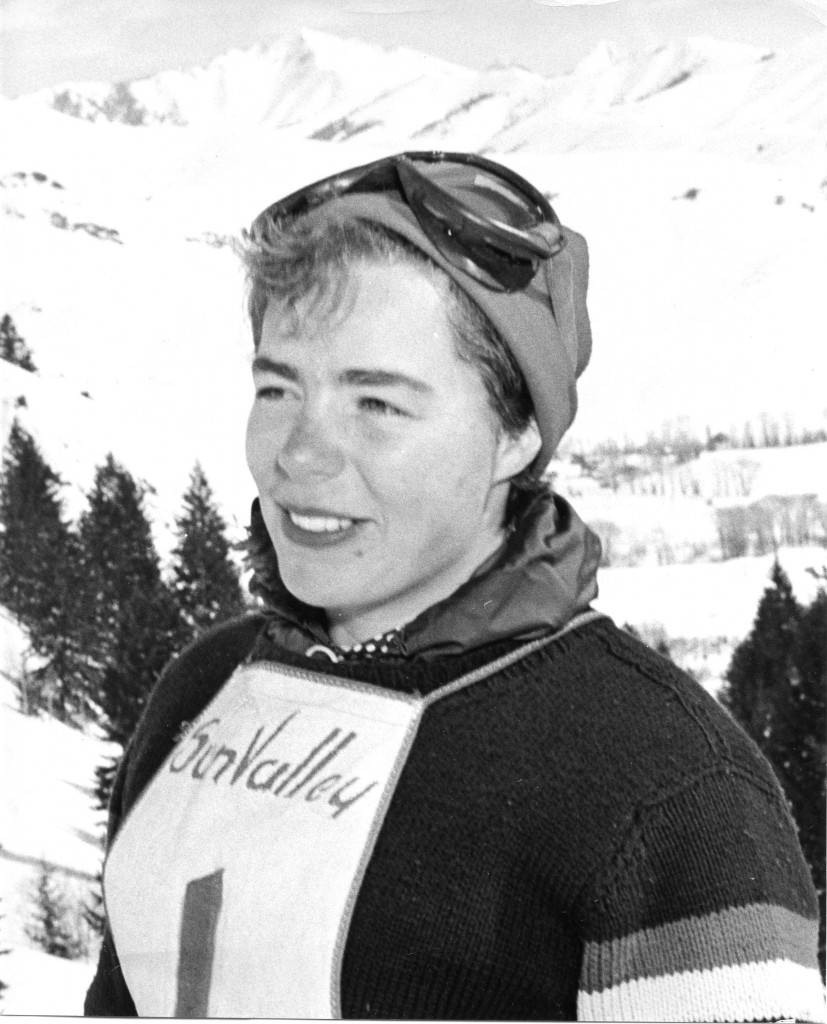On March 12, 2016, the Hannes Schneider Meister Cup Race at Cranmore Mountain Resort will celebrate its 20th year as a benefit event for the New England Ski Museum. The race is meant to keep alive the memory of Austrian skimeister Hannes Schneider, who was just settling into his new life in North Conway at Christmastime seventy five years ago.
On December 24, 1940, a magnitude 5.5 earthquake centered west of Whittier, New Hampshire shook homes and toppled chimneys in North Conway and across the region. Hannes Schneider and his son Herbert and daughter Herta were spending their second Christmas in his Grove Street home. Joining Schneider for the holidays was Arnold Lunn, the British ski pioneer and writer who together with Schneider had founded the Arlberg-Kandahar race in 1928, then the most important ski race in the world.

Benno Rybizka, Hannes Schneider, Arnold Lunn, Toni Matt and Herbert Schneider gather in 1940 at the Grove Street home of the Schneiders.
In February 1939, Schneider, who was persona non grata to the Nazi party in Austria, had been released from house arrest in Germany through still-mysterious negotiations between the Nazi government and North Conway native, New York über-banker and Cranmore founder Harvey Dow Gibson.
Arnold Lunn was the major personality among the British skiing community that flocked to the Swiss Alps in winter decades before skiing came to popularity in America, and as editor and most prolific writer for the widely-read British Ski Year Book, spread his views around the ski world. In 1940 Lunn was traveling in the United States with a sense of exile as the Battle of Britain was pummeling London.
The earthquake caused a fire in the house next to Hannes Schneider’s on Grove Street, and Lunn and Schneider joined in as neighbors pulled furniture out onto the street. When that excitement had passed, Schneider and Lunn spent the afternoon at the Eastern Slope Inn, where Lunn was gratified to see the Swiss band from the Palace Hotel in Mürren, now the house orchestra at the Inn.
That Arnold Lunn and Hannes Schneider, the preeminent ski pioneers of their time, were together in the small North Country village is notable enough, but also in town to give his first-ever lecture at the Eastern Slope Inn was Lowell Thomas, Jr., the son of explorer and radio broadcaster Lowell Thomas. Seventeen-year-old Thomas spoke about the expedition led by Bradford Washburn to Glacier Bay and the Fairweather Range in Alaska that he had accompanied the previous summer. Years later, Lowell Thomas, Jr. would become an accomplished bush pilot and lieutenant governor of Alaska.
Thomas’ lecture was put on by the Eastern Slope Ski Club to support its Junior Fund, and one of the many youths who would benefit from the club’s sponsorship a few years in the future was eight-year-old Imogene Opton, spending her first Christmas season in the United States. Imogene and her twin sister Roberta with their parents had fled the increasing chaos in their Berlin, Germany home in the spring of 1940, then settled on Kearsarge Street where her parents operated a small inn they called The Gables. Under the tree that first winter were skis for Imogene and Roberta. Within a short time they both became excellent skiers at Mount Cranmore.

Kennett High School valedictorian Imogen Opton placed fifth in the slalom in the 1952 Winter Olympic Games.
While at Kennett High School, coached by Hannes Schneider and Toni Matt, Imogene competed around the region with the help of the ESSC. Encouraged by Olympic skier Paula Kann, another European expatriate in North Conway, Imogene spent a year in Sun Valley training for the Olympic trials for the 1952 Winter Olympic Games. In Oslo in 1952 she would score the high point of her ski career with a solid fifth place in the women’s Olympic slalom.
In the holiday week of 1940, though, all that was in the future. Hannes Schneider and Arnold Lunn sat on the porch of the Meister Hut at the top of Mount Cranmore on Christmas Day and reflected on the war that was sweeping Europe. “All depends on England,” Hannes told Lunn. “If England holds out my country will rise again from the dead.” “We shall hold out, and you will be there on the platform to greet me, when I return to St. Anton for the Arlberg-Kandahar,” Lunn replied.
Despite the Christmas Eve tremors, in 1940 the real earthquake was in the local economy. With three pioneering ski areas at Whitney’s, Intervale and Cranmore, four more slopes with rope tows, at least ten slopes without tows, and six major walk-up trails built by the CCC, the Jackson-Bartlett-Conway locale had one of the greatest concentrations of ski venues in the country. Residents were learning that skiing brought with it enjoyment, employment and business development. The presence of Hannes Schneider, Arnold Lunn, Lowell Thomas Sr., Lowell Thomas Jr., and Imogen Opton, as well as other top skiers like Toni Matt and Paula Kann, in North Conway in that Christmas season 75 years ago, signified the emerging centrality of the Eastern Slope region to the embryonic American ski business.
